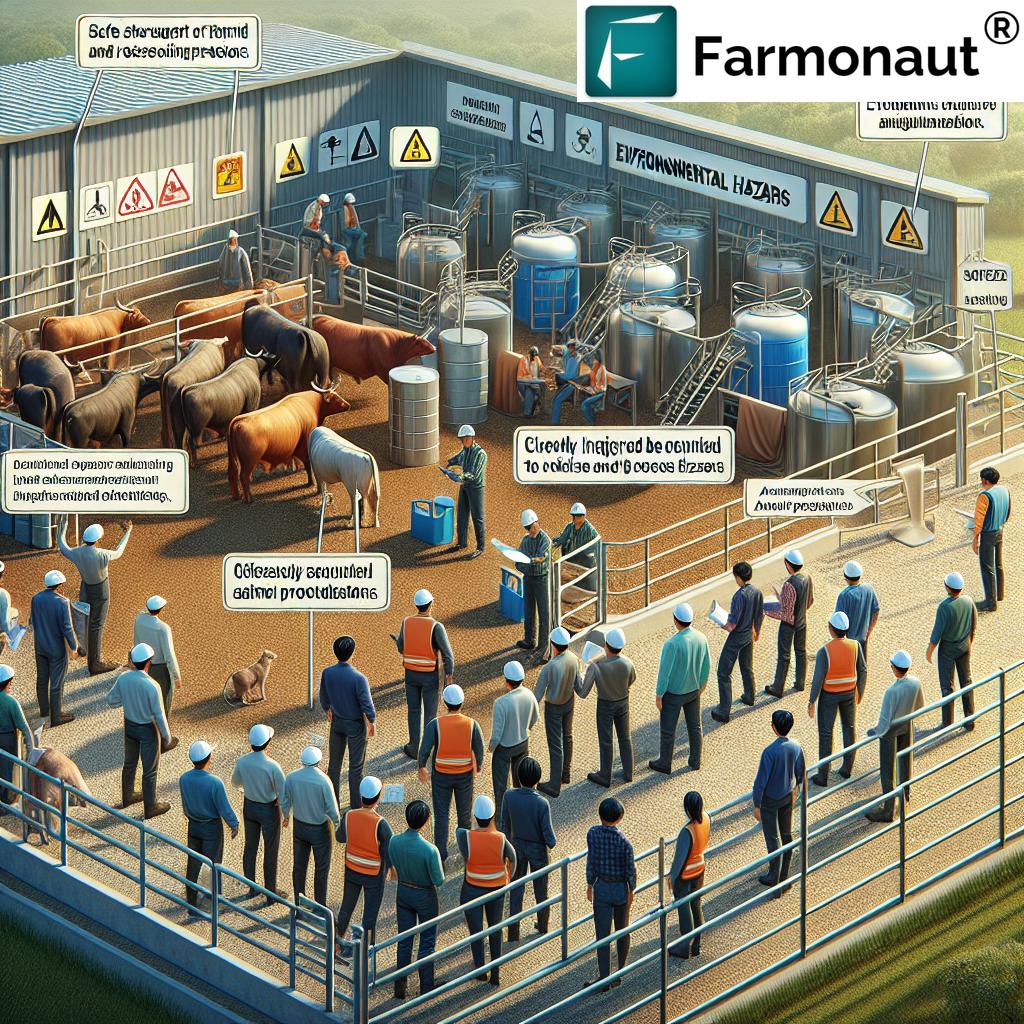Agricultural Health and Safety Risk Assessment: 7 Tips for Safer, Smarter Farming
“Over 170,000 agricultural workers suffer serious injuries annually due to unassessed hazards in farming operations.”
Table of Contents
- Introduction to Agricultural Health and Safety Risk Assessment
- The Importance of Risk Assessment in Agriculture
- Common Hazards in Agricultural Operations
- How to Conduct an Agricultural Health and Safety Risk Assessment
- 7 Essential Tips for Agricultural Health and Safety Risk Assessment
- Agricultural Hazards, Risk Levels, and Management Strategies Table
- Farmonaut Tools for Proactive Risk Management
- Frequently Asked Questions About Agricultural Health and Safety
- Conclusion
Introduction to Agricultural Health and Safety Risk Assessment
Agriculture is an essential pillar for economies worldwide, but it is also recognized as one of the most hazardous workplaces. From the rich farmlands across the United States to fields in every country, agricultural workers confront dangers every day. The agricultural health and safety risk assessment process aims to identify, evaluate, and mitigate hazards in agriculture, supporting not only compliance with industry regulations but also the well-being of workers and the productivity of farms.
With high reported rates of occupational injury and fatality, especially in regions with advanced industrial agriculture such as the United States, implementing effective strategies for risk management in farming is critical. In this comprehensive guide, we will uncover the scope of risk in agriculture, discuss practical agriculture risk management strategies, and share actionable advice for conducting risk assessments that safeguard both people and productivity. If you are engaged in farming, forestry, or agribusiness, these insights will help you create a more compliant, sustainable, and safe operation.
The Importance of Risk Assessment in Agriculture
Agriculture ranks among the world’s most dangerous industries. The sector’s risks and hazards range from machinery accidents, chemical exposure, and zoonotic diseases, to environmental factors. In the United States alone, the CDC reported a fatal injury rate of 18.6 per 100,000 workers—over five times higher than the national average for all occupations.
Implementing comprehensive risk assessments in agricultural operations serves multiple purposes:
- Protecting Workers: Identifying and controlling hazards in agriculture to decrease injuries and fatalities.
- Enhancing Productivity: Safe environments reduce downtime caused by accidents, improving overall output.
- Ensuring Compliance: Adhering to agricultural safety regulations, and meeting local, state, and federal occupational health and safety standards.
- Promoting Sustainability: Managing environmental risks in farming sustains the long-term viability of agricultural practices.
Through a proactive approach to risk assessment, agricultural leaders can instill a safety culture that protects workers and the environment, fosters continuous improvement, and achieves regulatory compliance.
“Implementing risk assessments can reduce farm-related accidents by up to 50%, according to global agricultural safety studies.”
Common Hazards in Agricultural Operations
Hazards in agriculture span a diverse set of threats, each demanding a tailored response. Below we outline the major risk categories in farming, using both US and global data to emphasize their seriousness.
-
Machinery and Equipment
- Tractors, harvesters, and other heavy equipment are frequent causes of accidents.
- Tractor overturns remain a leading cause of fatalities in the sector (learn about rollover protection structures).
- Improper maintenance can cause mechanical failures and lead to severe injuries.
-
Livestock Handling
- Animal interactions are unpredictable—bulls and large livestock frequently cause injuries or fatal accidents.
- Proper design of facilities and safety procedures are essential (see revised risk assessment).
-
Chemical Exposure
- Pesticides, fertilizers, and other agricultural chemicals pose risks of acute poisoning, chronic respiratory disease, and skin conditions.
- PPE and safe handling procedures are crucial (UK HSE agricultural guidance).
-
Environmental Hazards in Farming
- Extreme weather—such as heat waves, cold snaps, storms, and floods—puts both workers and crops at risk.
- Climate change may intensify these hazards, increasing the need for risk adaptation.
-
Ergonomic Hazards
- Repetitive tasks, lifting, and manual handling can lead to musculoskeletal disorders like back pain or chronic strain injuries.
-
Zoonotic Diseases
- Contact with animals can result in transmission of diseases such as leptospirosis, brucellosis, and Q fever, significantly affecting farmworker health (OSHA guidance).
These occupational risks in farming make agricultural health and safety risk assessment and management both a legal and a moral imperative.
How to Conduct an Agricultural Health and Safety Risk Assessment
A well-structured farm risk assessment is a critical process to safeguard workers and property. Conducting a risk assessment involves these systematic steps:
- Hazard Identification: Carefully recognize potential hazards associated with machinery, chemicals, animals, and environmental conditions.
- Risk Evaluation: Assess both the likelihood and severity of each hazard—prioritize those that pose the greatest threat to health and safety.
- Implementation of Control Measures: Use the hierarchy of controls to eliminate or mitigate risks. This may include engineering solutions (such as guards for machinery), administrative controls (shifts, rotations), and mandatory use of personal protective equipment in agriculture.
- Documentation: Keep detailed records of risk assessments, implemented controls, staff training, and reviews for legal compliance and continuous improvement.
- Regular Review and Revision: Continually review and update risk assessments to reflect changes in farming operations, new equipment, or updated regulations.
Regardless of your operation’s size, a comprehensive risk assessment should be a living document, guiding safety culture and management practices.
7 Essential Tips for Agricultural Health and Safety Risk Assessment
Effective agricultural safety is not about eliminating risk, but about recognizing, managing, and mitigating hazards smartly. These seven tips will guide your agricultural health and safety risk management journey:
1. Involve All Participants in Risk Assessment
- Risk is best identified by those who perform the tasks daily. Involve workers, supervisors, and safety personnel in identifying hazards and suggesting control measures.
- Promote a culture where everyone is responsible and empowered to address safety risks.
2. Use the Hierarchy of Controls
- Follow this prioritized order for risk reduction:
- Eliminate the hazard where feasible (e.g., replace hazardous chemicals).
- Substitute with safer alternatives.
- Engineer controls (guards, barriers, ventilation systems).
- Administer controls (training, safe work procedures, maintenance programs on equipment).
- Personal protective equipment (PPE) as the last line of defense.
- Example: For machinery safety in agriculture, installing rollover protection on tractors can prevent fatal accidents.
3. Maintain a Robust PPE Program
- Ensure workers have access to and are trained in the correct use of personal protective equipment in agriculture—from gloves and masks to boots and helmets.
- Inspect PPE before each use. Replace items showing signs of wear to maintain effectiveness.
- Post signage in work areas about required PPE and provide alternatives for different tasks and exposures (chemicals, machinery, or animals).
- Reference: Agricultural Safety and Health: Pocket Guide
4. Prioritize Machinery Safety in Agriculture Through Preventive Maintenance
- Create and follow a routine maintenance program for tractors, harvesters, and all powered equipment to prevent mechanical failures.
- Keep records of all inspections, repairs, and maintenance tasks for each type of agricultural equipment.
- Develop a lockout/tagout procedure for repairs to prevent accidental startups.
5. Establish Comprehensive Training and Emergency Response Procedures
- Conduct regular safety training on chemical handling, proper use of equipment, handling animals, and first-aid response for accidents.
- Organize and rehearse emergency drills (fire, weather event, chemical spill) to ensure all workers know evacuation routes and first-response actions.
- Display emergency contact numbers and procedures at key work locations.
6. Monitor Health, Promote Continuous Improvement, and Track Compliance
- Implement health surveillance programs to detect work-related illnesses early (respiratory, musculoskeletal, chemical exposure, and zoonotic diseases).
- Regularly review and revise risk assessments as tasks, equipment, or regulations change.
- Encourage worker feedback and provide mechanisms for confidential reporting of safety concerns.
7. Document, Audit, and Leverage Technology for Risk Management
- Keep timely and detailed documentation of every risk assessment process, training session, accident, and near miss.
-
Use smart technologies (like satellite-based crop and environment monitoring) to identify emerging risks in real-time. For example, Farmonaut delivers:
- Satellite alerts on field conditions and crop health, supporting safe pesticide and fertilizer usage.
- AI-powered advisory on safe farming practices and environmental risk prediction.
Discover more about smart, large-scale farm management with AI-backed analytics here:
Farmonaut’s Large Scale Farm Management App
Agricultural Hazards, Risk Levels, and Management Strategies Table
Below is a practical reference for quickly understanding agricultural hazards, their severity, and evidence-based management options.
| Hazard Type | Description of Hazard | Estimated Risk Level | Potential Health/Safety Impact | Recommended Risk Management Strategy |
|---|---|---|---|---|
| Machinery (Tractors, Harvesters) | Accidents during operation, tractor overturns, entanglement in moving parts | High | Severe injury, fatalities, loss of limb | Regular maintenance; install rollover protection; training; enforce lockout/tagout procedures |
| Livestock Handling | Bites, kicks, crushing from animals (especially bulls), zoonotic disease transmission | Medium-High | Fractures, bruises, infection, fatalities | Cattle facility design; animal behavior training; PPE (boots, gloves, eye protection) |
| Chemical Exposure | Handling or accidental release of pesticides, herbicides, fertilizers | High | Poisoning, respiratory issues, skin burns | PPE; safety data sheets; safe storage; chemical-handling training |
| Weather & Environment | Extreme heat, cold, storms, floods, drought | Medium | Heat stress, hypothermia, injury from debris | Weather monitoring; reschedule tasks; protective clothing; first aid preparedness |
| Ergonomic Hazards | Repetitive motions, heavy lifting, awkward postures | Medium | Back injuries, chronic pain, musculoskeletal disorders | Ergonomic training; mechanize repetitive tasks; rest breaks |
| Zoonotic Diseases | Animal-to-human transmission of bacteria, viruses, fungi | Medium | Flu-like illness, severe infection | Vaccination; hygiene protocols; PPE; monitoring animal health |
| Slips, Trips, Falls | Wet or uneven surfaces; exposure to mud or debris | Medium | Sprains, fractures, minor to serious injuries | Housekeeping; use slip-resistant footwear; improve lighting |
Farmonaut Tools for Proactive Risk Management
At Farmonaut, our mission is to make precision agriculture, and with it, proactive risk management, affordable and accessible for all scales of farming. We support agricultural health and safety by providing satellite-based insights, resource monitoring, and AI-driven recommendations that help identify and mitigate hazards early.
- Satellite-Based Crop and Environment Health Monitoring: Receive real-time alerts about field conditions, crop stress, or environmental anomalies using NDVI and other multispectral indices. This aids in addressing environmental hazards in farming—from predicting heat stress events to pinpointing chemical-related risks.
- Jeevn AI Advisory System: Get actionable, personalized advice on risk mitigation, safety practices, and timely interventions—whether optimizing irrigation to prevent slips and falls or selecting safer crop protection chemicals.
-
Resource and Fleet Management: Track and optimize the use of agricultural machinery and vehicles to reduce accidents, downtime, and costs.
Explore more about fleet-related risk management for both efficiency and safety:
Farmonaut Fleet Management -
Carbon Footprinting Solutions: Monitor, quantify, and manage environmental impacts, supporting sustainability and regulatory compliance.
Learn about how carbon tracking supports safe and sustainable farms:
Farmonaut Carbon Footprinting -
Blockchain-Based Traceability: Strengthen supply chain transparency and compliance with agricultural safety regulations using Farmonaut’s traceability platform.
See how our tech fosters compliance and trust from farm to consumer:
Farmonaut Product Traceability -
API Solutions: Integrate satellite data, weather, and risk analytics into your own systems using our
Farmonaut API and
Developer Docs. -
Crop Loan and Insurance Verification: Ensure accurate, satellite-based verification to support fair crop loans and insurance, reducing fraud risk and supporting financial sustainability.
See how satellite verification aids compliance:
Farmonaut Crop Loan & Insurance Verification
Frequently Asked Questions About Agricultural Health and Safety
What is an agricultural health and safety risk assessment?
It is a systematic process used in agriculture and forestry to identify, evaluate, and address hazards or risks within farming operations. The goal is to prevent accidents and illnesses by proactively implementing control measures.
Why do agricultural workers face so many risks?
Agriculture involves dangerous equipment, exposure to chemicals and animals, and challenging environmental conditions. Combined with diverse tasks and outdoor work, workers are frequently exposed to various hazards.
How can precision agriculture reduce agricultural risks?
By leveraging technology (like Farmonaut’s satellite monitoring), precision agriculture allows early detection of environmental stress, unsafe field conditions, or pest outbreaks—enabling workers to make safer, data-driven decisions.
How often should a farm risk assessment be reviewed?
It should be reviewed regularly—at least annually, and any time there are significant changes to operations, new equipment is introduced, there’s a new hazard, or after an incident.
What are the most important strategies for risk management in farming?
- Prioritize elimination and substitution of hazards where possible.
- Invest in preventive maintenance, staff training, and PPE.
- Document every assessment, incident, and training session.
- Use technology for real-time monitoring and risk alerts.
Is PPE alone enough for safety in agriculture?
No. PPE is the last line of defense. The best practices are to eliminate or control hazards at the source—PPE only mitigates risk when hazards cannot be engineered away or substituted.
Conclusion: Building a Safer, More Productive Agricultural Future
Conducting a comprehensive agricultural health and safety risk assessment is vital for every farm, whether in the fields of the United States or forestry operations globally. Identifying and addressing hazards—from machinery accidents to chemical exposure or zoonotic diseases—forms the cornerstone of modern agriculture risk management strategies.
By investing in continuous training, robust documentation, open worker participation, and advanced technology for monitoring both crops and environmental hazards, agricultural businesses can prevent accidents, enhance compliance, and improve productivity. This proactive approach ensures not only the safety and health of workers but also furthers sustainability goals, supports regulatory adherence, and boosts the long-term viability of agricultural operations.
At Farmonaut, we are passionate about making these capabilities accessible and affordable globally. By empowering agriculture with actionable data and AI, we aim to set new standards in risk management and occupational safety in farming, nurturing a robust safety culture for today and tomorrow.













